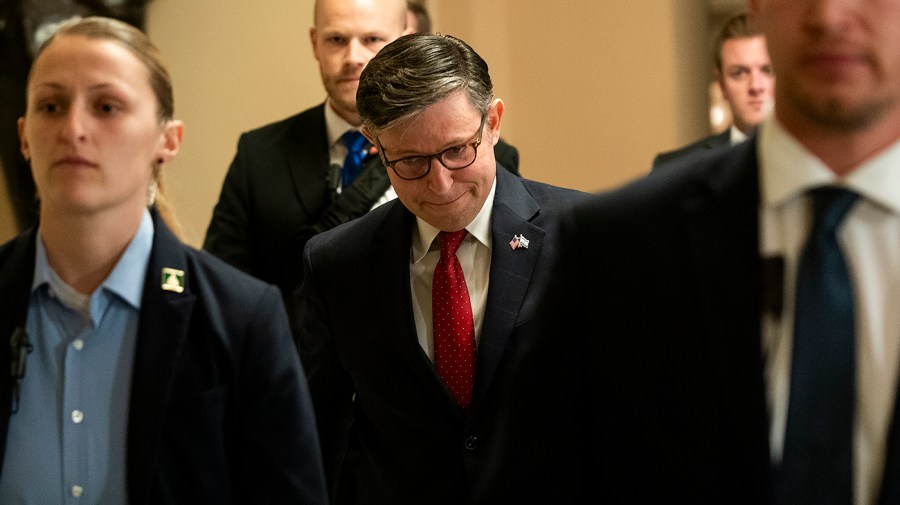Business
Fallout rises from McCarthy handshake deal with White House on December 11, 2023 at 11:00 am Business News | The Hill

Lawmakers in both parties are growing increasingly concerned about where a handshake deal between the White House and former Speaker Kevin McCarthy (R-Calif.) on spending stands as they negotiate how the government should be funded next year.
The Biden administration and House GOP leadership worked to pass legislation known as the Fiscal Responsibility Act (FRA) in late spring as part of a larger deal to suspend the debt ceiling and set budget caps for Congress to work from when it hashes out its full-year funding bills months later.
But now that Congress is trying to ramp up its annual appropriations work, critical components of that months-old deal that were not reflected in the law are in question as ultraconservatives, in pursuit of steeper cuts amid climbing debt, say Speaker Mike Johnson (R-La.) is not beholden to what Democrats say is the full commitment made by McCarthy.
“A deal is a deal is a deal,” Sen. Brian Schatz (D-Hawaii), who serves on the Senate Appropriations Committee, said this week. “I think there’s no way we’re going to get to an appropriations deal if people can’t hold to their commitments.”
In a letter to Republicans this week, Johnson said the FRA remains “the law of the land” that “provides the framework” for spending talks as both chambers work to reach a top-line agreement for fiscal 2024 funding.
On paper, lawmakers agreed to a base discretionary spending cap of $1.59 trillion, or about $886 billion for defense spending and almost $704 billion for nondefense spending, for fiscal 2024. However, the White House at the time detailed other changes to pad funding on the nondefense side, including rescinding billions of dollars in IRS funding with the purpose of reinvesting it in nondefense programs.
The IRS got $80 billion in additional funding last year, to be spent over the subsequent decade, in the Biden administration’s Inflation Reduction Act (IRA), much to the consternation of Republicans. As part of debt ceiling negotiations, the sides agreed that a quarter of the money could be repurposed in annual appropriations.
Ten billion dollars would be taken away from the IRS for fiscal 2024 and another $10 billion for fiscal 2025, to be added to nondefense discretionary funds, White House officials said earlier this year.
“We didn’t get into the individual line items in this bill,” Office of Management and Budget (OMB) Director Shalanda Young said in May. But she said lawmakers would “use IRS rescissions from the IRA on the mandatory side.”
“Again, we don’t dictate how,” she said, “but they will rescind $10 billion both years, and they will then use that to be reinvested into non-defense discretionary.”
The total $80 billion would have generated $200 billion in revenue over the 10-year budget window for a net deficit reduction of $120 billion, according to the Congressional Budget Office. Back-of-the-envelope math suggests the repurposed $20 billion will add $30 billion to the deficit, provided it’s not spent in revenue-generating programs.
White House officials also noted plans to repurpose other rescissions from clawed-back coronavirus relief dollars, which they acknowledged are pulled back in the law.
But as funding talks pick up between leadership in both chambers, the House Freedom Caucus is dialing up the heat on Johnson to hold the line, demanding in a Friday letter that any deal on a top-line level for government funding for fiscal 2024 “significantly reduce total programmatic spending year-over-year.”
The group also called on lawmakers to reject “side deals, gimmicks, or any other mechanism designed to hide the true number.”
“I think it’s very important that we hold to [$1.59 trillion], which was what the FRA agreed to,” Rep. Andrew Clyde (R-Ga.), a member of the House Freedom Caucus who is also an appropriator, said this week. “I mean, everybody voted for it. If we don’t do that, then I think that’s a problem.”
But Democrats and advocates are sounding alarm over the push.
Rep. Pramila Jayapal (D-Wash.), head of the Progressive Caucus, told The Hill this week that she’s “very” concerned about the potential cuts. “It has to be the whole deal.”
Sen. Jeanne Shaheen (D-N.H.) — whose subcommittee crafts the annual funding bill for the departments of Commerce, Justice and other agencies — also accused Republicans of “reneging,” adding the potential funding changes on the nondefense side make a difference for her subcommittee.
With the side deal included, Michael Linden, a former OMB official who was part of Biden’s negotiating team that hashed out the debt ceiling deal, argued the overall agreement would provide a “small increase” on the defense side and “flat-fund non-defense spending — which is a real cut, because costs go up every year.”
“That itself was a concession — a big concession — made in the service of avoiding exactly this kind of ridiculous back-and-forth, this procedural rigamarole, and just having Congress pass normal appropriations bills, which is what Republicans said they wanted,” he said in a Thursday interview.
Joel Friedman, senior vice president of federal fiscal policy at the Center on Budget and Policy Priorities, said the handshake agreement could fetch negotiators north of $60 billion in extra funding that could be redirected to the nondefense side.
“The only way you can get a freeze for nondefense is with the $69 billion in side deals,” he argued. “If you didn’t have that, it would have been a 9 percent in nondefense programs.”
“If it were a 9 percent cut, the White House wouldn’t have signed on. Senate Democrats and House Democrats wouldn’t have signed onto the deal. They wouldn’t have been able to reach agreement,” he said.
House, Appropriations, Business, News, Senate, Fiscal Responsibility Act, House Democrats, House GOP Lawmakers in both parties are growing increasingly concerned about where a handshake deal between the White House and former Speaker Kevin McCarthy (R-Calif.) on spending stands as they negotiate how the government should be funded next year. The Biden administration and House GOP leadership worked to pass legislation known as the Fiscal Responsibility Act (FRA)…
Business
Why 9 Million Americans Have Left

The Growing American Exodus
Nearly 9 million Americans now live outside the United States—a number that rivals the population of several states and signals a profound shift in how people view the American dream. This mass migration isn’t confined to retirees or the wealthy. Thanks to remote work, digital nomad visas, and mounting pressures at home, young professionals, families, and business owners are increasingly joining the ranks of expats.

Rising Costs and Shrinking Wallets
Living in the US has become increasingly expensive. Weekly grocery bills topping $300 are not uncommon, and everyday items like coffee and beef have surged in price over the last year. Rent, utilities, and other essentials also continue to climb, leaving many Americans to cut meals or put off purchases just to make ends meet. In contrast, life in countries like Mexico or Costa Rica often costs just 50–60% of what it does in the US—without sacrificing comfort or quality.
Health Care Concerns Drive Migration
America’s health care system is a major trigger for relocation. Despite the fact that the US spends more per person on health care than any other country, millions struggle to access affordable treatment. Over half of Americans admit to delaying medical care due to cost, with households earning below $40,000 seeing this rate jump to 63%. Many expats point to countries such as Spain or Thailand, where health care is both affordable and accessible, as a major draw.

Seeking Safety Abroad
Public safety issues—especially violent crime and gun-related incidents—have made many Americans feel unsafe, even in their own communities. The 2024 Global Peace Index documents a decline in North America’s safety ratings, while families in major cities often prioritize teaching their children to avoid gun violence over simple street safety. In many overseas destinations, newly arrived American families report a significant improvement in their sense of security and peace of mind.
Tax Burdens and Bureaucracy
US tax laws extend abroad, requiring expats to file annual returns and comply with complicated rules through acts such as FATCA. For some, the burden of global tax compliance is so great that thousands relinquish their US citizenship each year simply to escape the paperwork and scrutiny.
The Digital Nomad Revolution
Remote work has unlocked new pathways for Americans. Over a quarter of all paid workdays in the US are now fully remote, and more than 40 countries offer digital nomad visas for foreign professionals. Many Americans are leveraging this opportunity to maintain their US incomes while cutting costs and upgrading their quality of life abroad.

Conclusion: Redefining the Dream
The mass departure of nearly 9 million Americans reveals deep cracks in what was once considered the land of opportunity. Escalating costs, inaccessible healthcare, safety concerns, and relentless bureaucracy have spurred a global search for better options. For millions, the modern American dream is no longer tied to a white-picket fence, but found in newfound freedom beyond America’s borders.
Business
Will Theaters Crush Streaming in Hollywood’s Next Act?

Hollywood is bracing for a pivotal comeback, and for movie lovers, it’s the kind of shake-up that could redefine the very culture of cinema. With the freshly merged Paramount-Skydance shaking up its strategy, CEO David Ellison’s announcement doesn’t just signal a change—it reignites the passion for moviegoing that built the magic of Hollywood in the first place.

Theatrical Experience Roars Back
Fans and insiders alike have felt the itch for more event movies. For years, streaming promised endless options, but fragmented attention left many longing for communal spectacle. Now, with Paramount-Skydance tripling its film output for the big screen, it’s clear: studio leaders believe there’s no substitute for the lights, the hush before the opening credits, and the collective thrill of reacting to Hollywood’s latest blockbusters. Ellison’s pivot away from streaming exclusives taps deep into what unites cinephiles—the lived experience of cinema as art and event, not just content.
Industry Pulse: From Crisis to Renaissance
On the financial front, the numbers are as electrifying as any plot twist. After years of doubt, the box office is roaring. AMC, the world’s largest theater chain, reports a staggering 26% spike in moviegoer attendance and 36% revenue growth in Q2 2025. That kind of momentum hasn’t been seen since the heyday of summer tentpoles—and it’s not just about more tickets sold. AMC’s strategy—premium screens, with IMAX and Dolby Cinema, curated concessions, and branded collectibles—has turned every new release into an event, driving per-customer profits up nearly 50% compared to pre-pandemic norms.
Blockbusters Lead the Culture
Forget the gloom of endless streaming drops; when films like Top Gun: Maverick, Mission: Impossible, Minecraft, and surprise hits like Weapons and Freakier Friday draw crowds, the industry—and movie fans—sit up and take notice. Movie-themed collectibles and concession innovations, from Barbie’s iconic pink car popcorn holders to anniversary tie-ins, have made each screening a moment worth remembering, blending nostalgia and discovery. The focus: high-impact, shared audience experiences that streaming can’t replicate.
Streaming’s Limits and Studio Strategy
Yes, streaming is still surging, but the tide may be turning. The biggest franchises, and the biggest cultural events, happen when audiences come together for a theatrical release. Paramount-Skydance’s shift signals to rivals that premium storytelling and box office spectacle are again at the center of Hollywood value creation. The result is not just higher profits for exhibitors like AMC, but a rebirth of movie-going as the ultimate destination for fans hungry for connection and cinematic adventure.

Future Forecast: Culture, Community, and Blockbuster Dreams
As PwC and others warn that box office totals may take years to fully catch up, movie lovers and industry leaders alike are betting that exclusive theatrical runs, enhanced viewing experiences, and fan-driven engagement are the ingredients for long-term recovery—and a new golden age. The Paramount-Skydance play is more than a business move; it’s a rallying cry for the art of the theatrical event. Expect more big bets, more surprises, and—finally—a long-overdue renaissance for the silver screen.
For those who believe in the power of cinema, it’s a thrilling second act—and the best seat in the house might be front and center once again.
Business
Why Are Influencers Getting $7K to Post About Israel?

Influencers are being paid as much as $7,000 per post by the Israeli government as part of an expansive and sophisticated digital propaganda campaign. This effort is designed to influence global public opinion—especially among younger social media users—about Israel’s actions in Gaza and to counter critical narratives about the ongoing humanitarian situation.

How Much Is Being Spent?
Recent reports confirm that Israel has dedicated more than $40 million this year to social media and digital influence campaigns, targeting popular platforms such as TikTok, YouTube, and Instagram. In addition to direct influencer payments, Israel is investing tens of millions more in paid ads, search engine placements, and contracts with major tech companies like Google and Meta to push pro-Israel content and challenge critical coverage of issues like the famine in Gaza.
What’s the Strategy?
- Influencer Contracts: Influencers are recruited—often with all-expenses-paid trips to Israel, highly managed experiences, and direct payments—to post content that improves Israel’s image.
- Ad Campaigns: State-backed ad buys show lively Gaza markets and restaurants to counter global reports of famine and humanitarian crisis.
- Narrative Management: These posts and ads often avoid overt propaganda. Instead, they use personal stories, emotional appeals, and “behind the scenes” glimpses intended to humanize Israel’s side of the conflict and create doubt about reports by the UN and humanitarian agencies.
- Amplification: Paid content is strategically promoted so it dominates news feeds and is picked up by news aggregators, Wikipedia editors, and even AI systems that rely on “trusted” digital sources.
Why Is This Happening Now?
The humanitarian situation in Gaza has generated increasing international criticism, especially after the UN classified parts of Gaza as experiencing famine. In this environment, digital public relations has become a primary front in Israel’s efforts to defend its policies and limit diplomatic fallout. By investing in social media influencers, Israel is adapting old-school propaganda strategies (“Hasbara”) to the era of algorithms and youth-driven content.
Why Does It Matter?
This campaign represents a major blurring of the lines between paid promotion, journalism, and activism. When governments pay high-profile influencers to shape social media narratives, it becomes harder for audiences—especially young people—to distinguish between authentic perspectives and sponsored messaging.

In short: Influencers are getting $7,000 per post because Israel is prioritizing social media as a battleground for public opinion, investing millions in shaping what global audiences see, hear, and believe about Gaza and the conflict.

 Business3 weeks ago
Business3 weeks agoDisney Loses $3.87 Billion as Subscription Cancellations Surge After Kimmel Suspension

 Entertainment3 weeks ago
Entertainment3 weeks agoWhat the Deletion Frenzy Reveals in the David and Celeste Tragedy

 Entertainment4 weeks ago
Entertainment4 weeks agoABC Suspends ‘Jimmy Kimmel Live!’ Indefinitely After Kirk Remarks

 Entertainment3 weeks ago
Entertainment3 weeks agoExecutive Producer Debut: How Celia Carver Created Festival Hit ‘Afterparty’

 Film Industry4 weeks ago
Film Industry4 weeks agoCan Movie Theaters Steal the Show from Streaming?

 Health3 weeks ago
Health3 weeks agoRussia Claims 100% Success With New mRNA Cancer Vaccine

 News4 weeks ago
News4 weeks agoBody of Missing Teen Found in Tesla Linked to Musician D4vd

 Business4 weeks ago
Business4 weeks agoWhy Small Theaters Are Thriving While the Industry Struggles




























